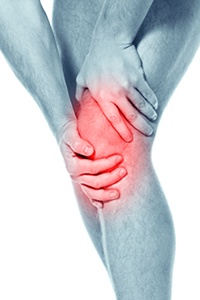Patello Femoral Pain Syndrome

Patellofemoral Pain Syndrome (PFPS) or “Anterior knee pain” refers to pain coming from the front part of your knee. Other names for this condition include “patellofemoral overload”, and “patellar chondromalacia”. It is one of the most common conditions affecting the knee joint.
Where does Anterior Knee Pain arise from?
PFPS arises when too much stress is applied to the patella (kneecap) where it contacts the groove of the femur (thigh bone). The pain also can be produced from the surrounding soft tissues including the knee joint capsule, tendons and ligaments.
Knee Anatomy
The patellofemoral joint is one of three compartments of the knee joint. As the knee straightens and bends, the patella moves in a groove on the femur called the trochlear groove. The patella is designed to glide into this groove as the cartilage covering the reciprocal surfaces of the femur and patella come into contact. The bones are formed so that the patella stays in the groove of the trochlea without moving out of place.
The quadriceps muscle at the front of the knee, especially the inner portion called the vastus medialis obliquis (VMO) help guide the patella into the trochlear groove as the knee bends. This muscle plays a critical role in helping the patella stay in its position and not slip out of place. The VMO also helps reduce shearing forces when the patella moves against the trochlea. There are also other supportive ligaments surrounding the patella which help it glide correctly within the trochlear groove.
Risk Factors
PFPS is extremely common throughout all age groups. It is especially seen in active healthy young athletes and teenage girls. This may arise from a weakness in the quadriceps muscle at the front of the thigh and its inner part (the VMO) that helps support the patella. Additionally poor flexibility, problems with anatomical alignment of the bones and inappropriate sports training techniques may exacerbate this problem. Occasionally a direct injury to the front of the patella may injure the cartilage of the patellofemoral joint and cause pain.
What symptoms commonly occur from PFPS?
Anterior knee pain symptoms commonly occur as the knee is bent whilst bearing weight. Common examples include walking up and down hills, ascending and descending stairs, and standing up after a period of prolonged sitting. The pain may come on insidiously, however, repeated bending activities such as jumping or squatting may have precipitated the pain. Sometimes there is a history of recurrent pain in this area.
Assessment
When you see one of the surgeons at Sydney Knee Specialists, you will have a history and examination performed in order to confirm the diagnosis of PFPS and exclude other associated problems. During the examination the surgeon will assess the alignment of your leg including the way that the patella glides in the trochlear groove as the knee bends. Weakness of the quadriceps muscle (VMO) will be assessed as well as any abnormal movements of the patella. Tenderness underneath the patella will be elicited as well as stability of the ligaments surrounding the knee joint. Flexibility of the hamstring and calf muscles will be examined as well as alignment of the feet as occasionally flat feet can exacerbate this problem.
Treatment
The main method of treating anterior knee pain involves initially rest, physiotherapy and occasionally medications.
Rest
Avoiding activities (such as squatting, jumping and stair climbing) where the knee is flexed into deep flexion can help settle your pain more quickly. Your surgeon will instruct you on proper techniques to reduce the pressure on the knee and alleviate symptoms whilst doing some bending activities. The most important thing to note is that any knee flexion weight-bearing exercise such as deep squatting past 60 degrees of knee flexion or deep lunges increase patellar pressures significantly.
Physiotherapy
As your pain improves, you will need to rehabilitate your knee to regain its motion, improve the strength of the muscles at the front of the knee and also improve your flexibility. This will not only speed up your recovery but will reduce the chances of your pain returning in the future.
The surgeons at SKS will often refer you to a physiotherapist for this rehabilitation to occur. The main focus of treatment is improving the muscle strength of the inner portion of the quadriceps muscle – the vastus medialis obliquis (VMO) as well as improving strength around the hip (gluteal muscles). Both muscle groups are very important in helping to reduce maltracking of the patella. As your strength increases, pain will often settle.
It is important that this muscle is strengthened in a non-painful manner and your surgeon and physiotherapist will give you appropriate exercises for this (See link on quadriceps strengthening exercises). Additionally your physiotherapist will focus on improving your hamstring flexibility (muscles at the back of your thigh) as tight hamstrings can place significant forces on the patella. There is a tendon on the outer aspect of the thigh called the iliotibial band (ITB) which may also be tight, producing pain. Improving flexibility of this tendon can also be addressed with physiotherapy. Other issues that may be corrected may be weakness of the hip rotator muscles (core muscle strengthening), and assessing the alignment of the foot, which can place abnormal forces on the patella itself.
Medications
Anti-inflammatories (NSAIDs) like Nurofen, Celebrex, Mobic and Voltaren are often used during painful periods to settle the early phases of the inflammation process. Starting on an anti-inflammatory can help make it easier for you to start your rehabilitation. These should only be taken for short courses as recommended by your surgeon.
Other Treatments
Taping the patella is often used to help the patella glide with less pressure. Your physiotherapist may trial this to see if it helps in relieving your anterior knee pain. Occasionally patellar braces may be useful in supporting the knee. Orthotics are often useful for people with flat feet as arch supports may improve the overall biomechanics of the lower limb. Over the counter arch supports are often a reasonable and relatively inexpensive option to trial.
Surgery
Surgery for PFPS is considered a last resort after all other treatments have failed. If there is fraying (chondromalacia) or a loose flap of cartilage behind the patella or on the trochlear groove, a knee arthroscopy may help smooth out the affected area. Sometimes the ligaments on the outer aspect of the patella are tight, causing it to tilt producing excessive pressure on the outer aspect of the patellofemoral joint. Releasing the tissues (a lateral release) may help reduce the tilting of the patella and the pressure on this side, improving your pain. Sometimes, a small part of the tibia bone (tibial tubercle) needs to be shifted so as to realign the way that the patella glides on the femur. This is called a tibial tubercle osteotomy. This is a larger operation and is used as a last resort in patients with severe pain not relieved by other modalities. The surgeons at SKS specialise in these procedures and we will discuss these options with you further if required. [See section on Tibial Tubercle Osteotomy].
 healthin
healthin